South African Class 91-000
The South African Railways Class 91-000 of 1973 was a narrow-gauge diesel–electric locomotive.
| South African Class 91-000 | |||||||||||||||||||||||||||||||||||||||||||||||||||||||||||||||||||||||||||||
|---|---|---|---|---|---|---|---|---|---|---|---|---|---|---|---|---|---|---|---|---|---|---|---|---|---|---|---|---|---|---|---|---|---|---|---|---|---|---|---|---|---|---|---|---|---|---|---|---|---|---|---|---|---|---|---|---|---|---|---|---|---|---|---|---|---|---|---|---|---|---|---|---|---|---|---|---|---|
 Numbers 91-003 and 91-009 on the limestone train from Loerie PPC to New Brighton | |||||||||||||||||||||||||||||||||||||||||||||||||||||||||||||||||||||||||||||
| |||||||||||||||||||||||||||||||||||||||||||||||||||||||||||||||||||||||||||||
| |||||||||||||||||||||||||||||||||||||||||||||||||||||||||||||||||||||||||||||
| |||||||||||||||||||||||||||||||||||||||||||||||||||||||||||||||||||||||||||||
| |||||||||||||||||||||||||||||||||||||||||||||||||||||||||||||||||||||||||||||
Between September and December 1973, the South African Railways placed twenty Class 91-000 General Electric type UM6B diesel–electric locomotives in service on its narrow-gauge Avontuur Railway between Port Elizabeth in the Eastern Cape and Avontuur in the Western Cape. Some of them later also worked on the Alfred County Railway out of Port Shepstone in KwaZulu-Natal.[1][2][3]
Manufacturer
The Class 91-000 GE type UM6B diesel–electric locomotive was designed and built for the South African Railways (SAR) by General Electric (GE) in Erie, Pennsylvania. Twenty locomotives were delivered between September and December 1973, numbered in the range from 91-001 to 91-020. It was designed for 2 ft (610 mm) narrow gauge and is the largest two-foot-gauge diesel–electric locomotive in the world at a maximum weight of 48,000 kilograms (106,000 pounds).[3][4]

GE's usual practice was to attach locomotive builder's works plates to the unit's frame below the cab. The Class 91-000 units were delivered with their works plates mounted below their number plates on the cabsides. When they were repainted in the Spoornet orange livery in the 1990s, the SAR number plates were removed and these works plates were relocated to each side of the long hood. With the exception of numbers 91-001 (GE 38604), 91-002 (GE 38603), 91-016 (GE 38619) and 91-017 (GE 38618), the Class 91-000 works numbers are in sequence with their unit numbers. It is very likely that the out-of-sequence works plates were the result of body panels being swapped between locomotives during overhauls.[3][5]
Characteristics
As a result of the severe clearance problems presented by the two-foot gauge, it was not possible to follow the usual practice of axle-hung traction motors. Special bogies had to be designed with both traction motors mounted between the axles and with one traction motor on each side of each bogie.[2][3]
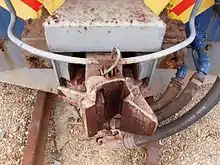
The locomotives are air as well as dynamically braked. A lag control was incorporated into the train's brake pipes to prevent bunching of the wagons upon braking and snatching upon restarting. This, combined with the cabling required for multi-unit control, resulted in altogether seven cable connections between consisted units.[2]
The Class 91-000 also introduced the new Willison or SA3 coupler which replaced the old Bell-and-hook type coupler on new Avontuur Railway rolling stock acquired for limestone traffic in the 1970s.[2]
Service
South African Railways
The Class 91-000 replaced the ageing Class NG G13 and NG G16 Garratts which had been working the Langkloof narrow gauge line until then, but for a number of years it worked alongside the Class NG15 Kalahari steam locomotives. It is the only diesel–electric locomotive type to have operated on South Africa's narrow-gauge lines.[2]
These locomotives served nearly exclusively on the Langkloof line, but between 1992 and December 2003 a few of them also worked on the Alfred County Railway (ACR) narrow-gauge line out of Port Shepstone. Units which were transferred to and from Natal usually travelled all the way from Port Elizabeth under their own power on what became known as Bigfoot bogies, which were actually 3 ft 6 in (1,067 mm) Cape gauge Class 36-000 GE type SG10B bogies. These Bigfoot bogies were also used under the Class 91-000 locomotives whenever they had to be exchanged for maintenance purposes, sometimes running under their own power, sometimes hauled dead.[5]
Over the years since the Class 91-000 was commissioned, the demand for rail services declined steadily on both the ACR and the Langkloof lines. Still, even though road transport had triumphed over rail transport in respect of fruit traffic in the Langkloof by the 1980s, the eastern part of the line remained busy for some years hauling limestone from Loerie. When the quarry that fed Loerie station by cableway was closed, however, the fate of the narrow-gauge line was virtually sealed.[6]
Despite this, in the Avontuur Railway's centenary year in 2003 Spoornet still stated its commitment to keep the line in service by undertaking to invest in infrastructure and technology. As late as September 2005 there was even talk of extending the 107-kilometre long (66-mile) branch line from Loerie further into the Gamtoos valley to assist farmers who had difficulty moving their produce.[7]
Of the twenty locomotives built, eighteen were still operational in 2009, two having been withdrawn after accident damage.[5] However, Transnet Freight Rail (TFR) had decided that narrow-gauge railway operations were no longer in its "core line of business" and began putting some of the locomotives up for auction.
One Class 91-000 locomotive, no. 91-010, was still in service with TFR in 2013. It was mounted on Bigfoot bogies of which only one was equipped with traction motors, and equipped with AAR knuckle couplers for use as a shunting engine at the Swartkops electric locomotive depot in Port Elizabeth. This is the locomotive that was purchased by the Sandstone Estate less the bogies. The rest of the fleet which were still on the TFR roster were standing idle, staged at the narrow-gauge depot at Humewood Road in Port Elizabeth. Mass scrapping of these locomotives is expected to take place in January 2019.
Industrial service
Five locomotives were sold to RRL Grindrod, a joint venture between Solethu Investments, a South African Black Economic Empowerment (BEE) rail logistics company, and Grindrod Limited, a shipping and logistics group, for use at Welkom in the Free State to haul mine hoppers. Four of them were renumbered in the range from RRL 91-01 to 91-04 and their original narrow-gauge bogies were cut in half and widened to 3 ft 6 in (1,067 mm) Cape gauge. The fifth was the accident-damaged no. 91-009 which was completely rebuilt with a 700hp Caterpillar main engine It is today (December 2018) the Capitol Park Shunter for Rovos Rail and has been re-numbered 91-011. engine-generator.[8][9][10]
Three more units were sold at auction on 11 July 2013. These were purchased by a Port Elizabeth scrap merchant for rebuilding and resale. One (91-011) was sold to Argentina. By April 2017 both those remaining 13/18 are in storage in restored condition inside the Humewood Road diesel depot and are for sale (December 2018). One was used locally in December 2017 as a replacement for a failed NG15 on tourist train duty.
Preservation
No. 91-001 is preserved at the Outeniqua Transport Museum in George.
Two units, numbers 91-006 and 91-007, were transferred to Paton's Country Narrow Gauge Railway in 2015. They are in use on the narrow-gauge tourist trains running from Allwoodburn Siding at Ixopo in KwaZulu-Natal.
No. 91-010 was sold to Sandstone Estates in basic operating condition and arrived at their facility by road on 31 October 2016. After some maintenance and correction of faults, it performed route-proving runs during the first week of April 2017. It then entered regular service on the Sandstone Railroad during the Sandstone Stars of 2017 event. Its first duty was the recovery of NG/G16 88 which had failed at Vilima. 91-016 and 91-019 were also purchased by the Sandstone Estates in September 2017 and February 2019 respectively.
.jpg.webp)
In December 2018 it was confirmed that the Apple Express organization based at Humewood Road have purchased 91-005 and leased 91-020 from the THF. 91-005 was started up for the first time in 12+ years in December 2018.
Works numbers
The Class 91-000 builder's works numbers and their known disposal are listed in the table.[5]
Loco no. |
Works no. |
Disposal |
|---|---|---|
| 91-001 | 38604 | On display at Outeniqua Transport Museum in George. |
| 91-002 | 38603 | Sold for scrap November 2018. |
| 91-003 | 38605 | Sold for scrap November 2018. |
| 91-004 | 38606 | Sold for scrap November 2018. |
| 91-005 | 38607 | Humewood Road diesel depot. Sold to the Apple Express organization in November 2018. Operational. |
| 91-006 | 38608 | Paton's Country Narrow Gauge Railway Ixopo. Operational. |
| 91-007 | 38609 | Paton's Country Narrow Gauge Railway Ixopo. Operational. |
| 91-008 | 38610 | Sold for scrap November 2018. |
| 91-009 | 38611 | RRL rebuilt as gen-set UL-01 Capitol Park (Rovos Rail) Shunter on 3'6" gauge bogies (Numbered 91-011) Operational. |
| 91-010 | 38612 | Sandstone Railroad. Stored Operational |
| 91-011 | 38613 | Sold by Transnet at auction 11 Jul 2013 to Versarail, Overhauled and re-sold in 2017 to BTU Argentina using Meter Gauge Bogies. Operational. |
| 91-012 | 38614 | Sold for scrap 2017 |
| 91-013 | 38615 | Sold by Transnet at auction 11 Jul 2013 to Versarail. Operational, regauged to Meter and leased to Madagascar, October 2020 |
| 91-014 | 38616 | Scrapped Feb 1997 following wreck. |
| 91-015 | 38617 | Sold for scrap November 2018. |
| 91-016 | 38619 | Sold to Sandstone Estates for spare parts in 2017. Currently on 3'6" bogies. |
| 91-017 | 38618 | Sold for scrap 2017. |
| 91-018 | 38620 | Sold by Transnet at auction 11 Jul 2013 to Versarail. Operational, regauged to Meter and leased to Madagascar October 2020 |
| 91-019 | 38621 | Humewood Depot Sold for scrap November 2018 then re-sold to Sandstone Estates in February 2019. |
| 91-020 | 38622 | Humewood Depot To be retained by the THF for lend lease to the Apple Express organization. |
Liveries
The Class 91-000 were all delivered in the SAR Gulf Red livery with signal red buffer beams, yellow side stripes on the long hood sides and a yellow V on each end. In the 1990s they began to be repainted in the Spoornet orange livery with a yellow and blue chevron pattern on the buffer beams. Only one, 91-001, was repainted in the Spoornet blue livery with outline numbers on the long hood sides in about 2006.[11]
Illustration
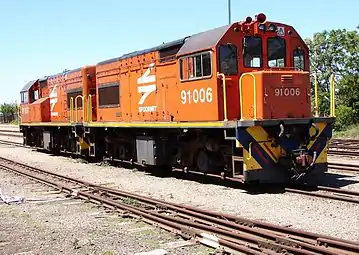 No. 91-006 at Humansdorp station, 18 October 2009
No. 91-006 at Humansdorp station, 18 October 2009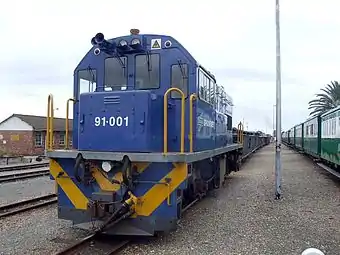 No. 91-001 at Humewood Road, Port Elizabeth, 20 December 2006
No. 91-001 at Humewood Road, Port Elizabeth, 20 December 2006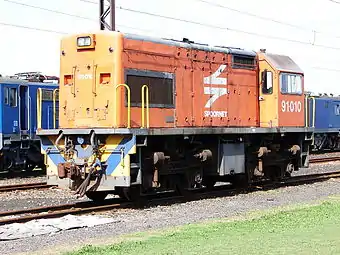 Bigfoot no. 91-010 in shunting service at Swartkops, Port Elizabeth, 21 April 2013
Bigfoot no. 91-010 in shunting service at Swartkops, Port Elizabeth, 21 April 2013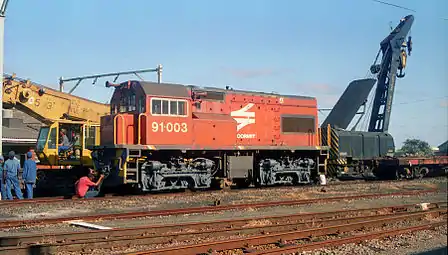 No. 91-003 being equipped with Bigfoot bogies, Port Shepstone, 8 April 2004
No. 91-003 being equipped with Bigfoot bogies, Port Shepstone, 8 April 2004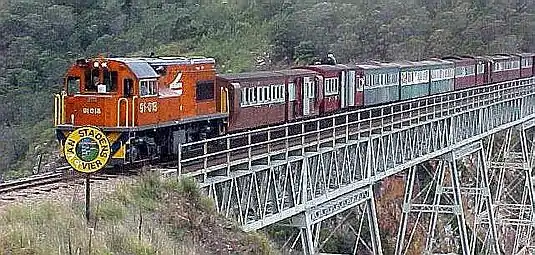 No. 91-018 crossing the Van Stadens River with the Apple Express, 6 April 2002
No. 91-018 crossing the Van Stadens River with the Apple Express, 6 April 2002
References
| Wikimedia Commons has media related to South African Class 91-000. |
- South African Railways Index and Diagrams Electric and Diesel Locomotives, 610 mm and 1065 mm Gauges, Ref LXD 14/1/100/20, 28 January 1975, as amended
- Paxton, Leith; Bourne, David (1985). Locomotives of the South African Railways (1st ed.). Cape Town: Struik. p. 144. ISBN 0869772112.
- Soul of A Railway, System 3, Part 1: Cape Midland, based in Port Elizabeth, Part 1, The Port Elizabeth Narrow Gauge. Captions 36-39, 41-42. (Accessed on 10 December 2016)
- Class 91-000 page from the SAR Index and Diagrams of Electric and Diesel Locomotives, Ref LXD 14/1/100/20, Issued 28/1/75 (Accessed on 8 June 2017)
- Middleton, John N. (2002). Railways of Southern Africa Locomotive Guide - 2002 (as amended by Combined Amendment List 4, January 2009) (2nd, Dec 2002 ed.). Herts, England: Beyer-Garratt Publications. pp. 38–39, 45.
- Railways Africa, 18 Jan 2007: Revamping the Apple Express (Accessed on 8 June 2017)
- 100 Years of Being at the Heart of It All, Spoornet brochure, Circa 2003
- Railways Africa, 8 Mar 2007: Langkloof narrow-gauge (Accessed on 8 June 2017)
- Railways Africa, 19 Apr 2010: Class 91 Diesels in the OFS (Accessed on 8 June 2017)
- Railways Africa, 5 Feb 2010: Transnet Freight Rail Auction Results (Accessed on 8 June 2017)
- Soul of A Railway, System 7, Western Transvaal, based in Johannesburg, Part 9. South-Eastwards as far as Volksrust (2nd part) by Les Pivnic. Caption 4. (Accessed on 11 April 2017)